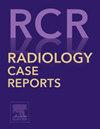Recurrent renal cell carcinoma post cryoablation secondary to splenorenal shunt thermal sink treated with venous obliteration and subsequent cryoablation
Q4 Medicine
引用次数: 0
Abstract
Cryoablation is an effective treatment for T1a renal cell carcinoma but is subject to dissipation of ablative energy via adjacent blood vessel perfusion, known as thermal sink, which may reduce efficacy. Reduction of blood flow in structures responsible for thermal sink during ablations can limit this effect. We report a 55-year-old patient with cirrhosis complicated by portal hypertension and a recurrent left renal cell carcinoma after 2 cryoablations secondary to thermal sink from an abutting splenorenal shunt (SRS). He subsequently underwent transjugular intrahepatic portosystemic shunt creation done with SRS obliteration followed by cryoablation without recurrence. This case highlights a rare instance of thermal sink from an external vessel and demonstrates how addressing sources of thermal sink can improve ablation outcomes in select cases.
低温消融后脾肾分流热沉继发复发性肾细胞癌的静脉闭塞和随后的低温消融治疗
冷冻消融是治疗T1a肾细胞癌的有效方法,但消融能量会通过邻近血管灌注耗散,称为热沉,这可能会降低疗效。在消融过程中,负责热沉的结构中血流的减少可以限制这种影响。我们报告一位55岁的肝硬化合并门静脉高压症和复发性左肾细胞癌的患者,在邻近的脾肾分流术(SRS)中继发热沉的2次冷冻消融后。随后,他接受了经颈静脉肝内门静脉系统分流术,SRS闭塞后冷冻消融,无复发。本病例强调了一个罕见的外部容器热沉的实例,并展示了如何解决热沉的来源可以改善某些情况下的消融结果。
本文章由计算机程序翻译,如有差异,请以英文原文为准。
求助全文
约1分钟内获得全文
求助全文
来源期刊

Radiology Case Reports
Medicine-Radiology, Nuclear Medicine and Imaging
CiteScore
1.10
自引率
0.00%
发文量
1074
审稿时长
30 days
期刊介绍:
The content of this journal is exclusively case reports that feature diagnostic imaging. Categories in which case reports can be placed include the musculoskeletal system, spine, central nervous system, head and neck, cardiovascular, chest, gastrointestinal, genitourinary, multisystem, pediatric, emergency, women''s imaging, oncologic, normal variants, medical devices, foreign bodies, interventional radiology, nuclear medicine, molecular imaging, ultrasonography, imaging artifacts, forensic, anthropological, and medical-legal. Articles must be well-documented and include a review of the appropriate literature.
 求助内容:
求助内容: 应助结果提醒方式:
应助结果提醒方式:


